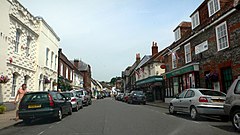Bishop Waltham
| Bishop's Waltham | |
|---|---|
 Bishop's Waltham High Street |
|
|
Bishop's Waltham shown within Hampshire
|
|
| Population | 6,723 (2011 Census) |
| OS grid reference | SU554174 |
| District | |
| Shire county | |
| Region | |
| Country | England |
| Sovereign state | United Kingdom |
| Post town | Winchester |
| Postcode district | SO32 |
| Dialling code | 01489 |
| Police | Hampshire |
| Fire | Hampshire |
| Ambulance | South Central |
| EU Parliament | South East England |
| UK Parliament | |
Bishop's Waltham is a medieval market town situated at the source of the River Hamble in Hampshire, England. It has a foot in the South Downs National Park and is located at the midpoint of a long-established route between Winchester and Portsmouth. It is home to the ruins of Bishop's Waltham Palace, a Scheduled Ancient Monument under English Heritage management, and a well-preserved high street with many listed buildings which now house independent shops.
Bishop's Waltham's long history includes a role call of Medieval and Tudor kings and queens who visited the town to stay at the palace. The name of the town is Saxon, being derived from the two words: "wald" (forest) and "ham" (settlement).
Modern day Bishop's Waltham has a population of over 6,500 and is the largest settlement in the Winchester district outside the city itself. It is home to an infant and junior school, with a secondary school (Swanmore College) 2 miles away in Swanmore.
The town's name comprises three parts 'walt' – forest; 'ham' – settlement'; and 'Bishop's'. It started off as an Anglo-Saxon village, and steadily grew to become one of Hampshire's largest villages, despite being burnt to the ground by Danes in 1001 AD. By the time of the Domesday book (1086 AD), it had a population of around 450. In 904, it was given by the king to the Bishop of Winchester. In 1136 Henry de Blois, a later bishop, built the now-ruined Bishop's Waltham Palace. It was destroyed on the orders of Oliver Cromwell during the English Civil War. Much of the old Palace is still in the town. Apart from the ruins, which are open to the public, material from the Palace was used as building materials in town buildings still standing to this day.
William of Wykeham died in the town, while after the Battle of Trafalgar, some French sailors including Admiral Villeneuve were imprisoned there.
...
Wikipedia

